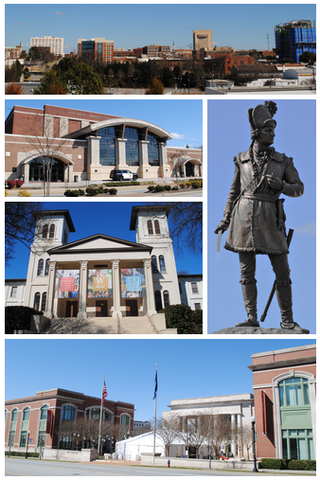
Spartanburg is a city in and the seat of Spartanburg County, South Carolina, United States. The city of Spartanburg has a municipal population of 38,732 as of the 2020 census, making it the 11th-largest city in the state. For a time, the Office of Management and Budget (OMB) grouped Spartanburg and Union Counties together as the Spartanburg metropolitan statistical area, but the OMB now defines the Spartanburg MSA as only Spartanburg County.

Converse University is a private university in Spartanburg, South Carolina. It was established in 1889 by a group of Spartanburg residents and named after textile pioneer Dexter Edgar Converse. It was originally a women's college but now admits men and women to its undergraduate college and its graduate, online, and summer programs.

The South Carolina School for the Deaf and the Blind is a school in unincorporated Spartanburg County, South Carolina, United States, near Spartanburg and with a Spartanburg postal address. It was founded in 1849 by the Reverend Newton Pinckney Walker as a private school for students who were deaf. The School for the Blind was established in 1855, and the school became state funded in 1856.
Glendale is a census-designated place located in Spartanburg County in the U.S. State of South Carolina. According to the 2010 United States Census, the population was 307.
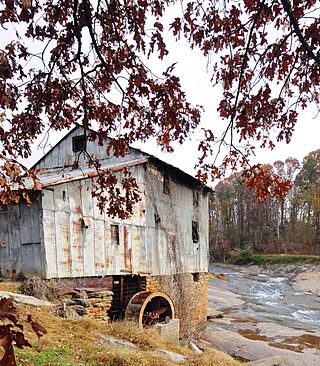
For the mill of the same name see Anderson's Mill, Smeaton
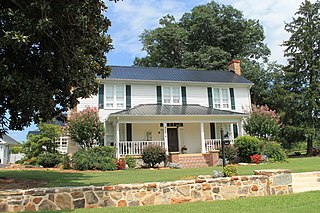
The Bush House is a historic house located at 3960 New Cut Road near Inman, Spartanburg County, South Carolina.

Pacolet Mills Cloth Room and Warehouse is a historic textile mill located at Pacolet, Spartanburg County, South Carolina. It was built in 1906–1907, and consists the 1 1/2-story, brick cloth building with the attached warehouse portion covered with weatherboard and metal. the building features a low-profiled roof and large rounded arch windows. The front portion of the building was used for inspecting cloth prior to shipping, and the rear portion was used as a warehouse.
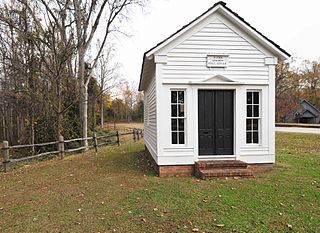
Glenn Springs Historic District is a national historic district located at Glenn Springs, Spartanburg County, South Carolina. It encompasses 18 contributing buildings and 3 contributing sites in the historic health resort of Glenn Springs. The community developed as a resort around the mineral springs between about 1840 and 1940. The district includes several residences, two boarding houses, Cates House Ruins, Calvary Protestant Episcopal Church, Presbyterian Church, Cates Store, Glenn Springs Post Office, a pavilion, a cemetery, and the site of the Glenn Springs Hotel. It includes notable buildings in the Greek Revival, Gothic Revival, Queen Anne, and Bungalow styles.

Converse Heights Historic District is a national historic district located at Spartanburg, Spartanburg County, South Carolina. It encompasses 460 contributing buildings in a residential section of Spartanburg. The district documents the prevalent housing types for middle and upper class citizens from about 1900 to 1940. It includes residences representative of the Queen Anne, American Foursquare, American Craftsman, Spanish Mission, Tudor, Colonial Revival, and Neo-Classical styles.

Bon Haven, also known as The Cleveland House, was an historic home located in Spartanburg, Spartanburg County, South Carolina. It was built about 1884, and was a two-story, brick Second Empire style dwelling with 1920s Neo-Classical style additions. It featured a mansard roof, central tower and massive Ionic order columns and portico. Its builder, John B. Cleveland, was a founder and trustee of Converse College, a trustee of Wofford College, and played a role in the establishment of Spartanburg's city school system. It was listed on the National Register of Historic Places in 1976.

Bishop William Wallace Duncan House, also known as the DuPre House, is a historic home located at Spartanburg, Spartanburg County, South Carolina. It was designed by G. L. Norrman and built about 1886. It is a two-story, asymmetrical, clapboard and cedar shingled dwelling in the Queen Anne style. It has a high-pitched roof pierced by six chimneys, a decorative mosaic tile front porch landing, a massive wood shingle-clad cylindrical tower, and stained glass windows. It was moved from its original location at 249 N. Church St. to its present location in November 1999.

Evins-Bivings House, also known as the Dr. James Bivings House, is a historic home located at Spartanburg, Spartanburg County, South Carolina. It was built about 1854, and is a two-story, white clapboard house in the Greek Revival style. The house features double piazzas with massive Doric order columns and notable balustrades. Also on the property are the original kitchen, slave quarters, smokehouse, and well. It was built by Dr. James Bivings, who founded Glendale Mills.

Jammie Seay House is a historic home located at Spartanburg, Spartanburg County, South Carolina. It was built between 1770–1800, and is one-story, log house with a loft, field stone foundation piers, gabled roof, and an end field stone chimney. It has a one-story "L" rear addition and a one-story lean-to front porch. It was built by Jammie Seay, a Revolutionary War soldier of the Second Virginia Infantry. It is believed to be the oldest house within the present limits of Spartanburg.
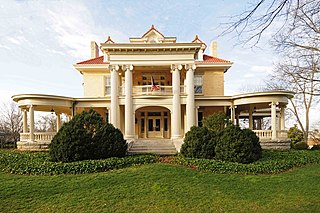
Walter Scott Montgomery House is a historic home located at Spartanburg, Spartanburg County, South Carolina. It was designed by architect George Franklin Barber and built in 1909. It is a 2+1⁄2-story, frame, yellow brick-veneer residence in the Colonial Revival style. building is of frame construction with a yellow brick veneer and a red tile roof. It features a distinctive portico and leaded glass windows. Also on the property is a one-story, reinforced concrete auto garage.

Fremont School, also known as Freemont School, is a historic elementary school building located in Spartanburg, Spartanburg County, South Carolina. It was built in 1915, and is a two-story, brick Classical Revival style building with a partially raised basement, and a major addition built in 1926. It features decorative brickwork, terra cotta ornamentation, and entrance porticoes. The building housed an elementary school from 1915 to 1979.

Old Woodruff High School is a historic high school building located at Woodruff, Spartanburg County, South Carolina. It was built in 1925, and is a two-story, modified "H" plan stuccoed masonry building in the Collegiate Gothic style. It consists of a three-part center section with two perpendicular wings. The building has a flat roof with parapet, Gothic arches, recessed entrances framed by pointed arches. The building housed a high school until 1953 when Woodruff High School was constructed, then used as a middle school and later an elementary school. In 1978 the City of Woodruff acquired old Woodruff High School and adapted it for use as its city hall and police headquarters.
Myrtle Moor is a historic plantation house located near Sumter, Sumter County, South Carolina. It was built about 1825–1840, and is a large, two-story, "L"-shaped" frame farmhouse embellished with vernacular interpretations of the Federal and Greek Revival styles.. The front façade features a one-story full shed roof porch supported by six chamfered wooden posts. Also on the property are the contributing commissary, a barn, and a speculated servant's quarters/kitchen.

Banks-Mack House is a historic home located at Fort Mill, York County, South Carolina. It was built about 1871, and enlarged and renovated in the Classical Revival style in 1910. It is a two-story, frame dwelling with a one-story, hip roofed wraparound porch. The porch once encompassed a large hickory tree that was removed because of damage from Hurricane Hugo in September 1989.
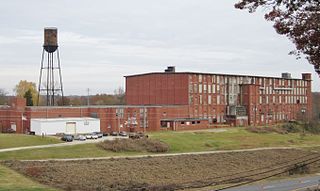
The Converse Mill, also known as Clifton Mill #3, is a historic textile mill at 200 High Street in Spartanburg, South Carolina. The main mill building is a four-story brick building with smaller additions, sited on 11 acres (4.5 ha) overlooking the Pacolet River to the east. The mill was built in 1903 on the site of Clifton Mill #3, then the largest textile mill in the world, which had been destroyed by flood. It was designed by the noted industrial architectural firm Lockwood, Green of Boston, Massachusetts. The mill was closed sometime between 1968 and 1973, after which many of its windows were bricked over and it was converted to a warehouse. It is the only surviving element of the Clifton Mill complex, which originally had three large buildings.It is currently being renovated into apartments, some of which have views of the Pacolet River.

Dexter Edgar Converse (1829–1899) a was a textile entrepreneur who was co-founder and namesake of Converse College. Converse was native of Vermont who had moved to Spartanburg prior to the American Civil War and had become a successful pioneer in the cotton mill industry, and served as the head of the Converse College's first board of directors and was among the school's founders and substantial donors.






















